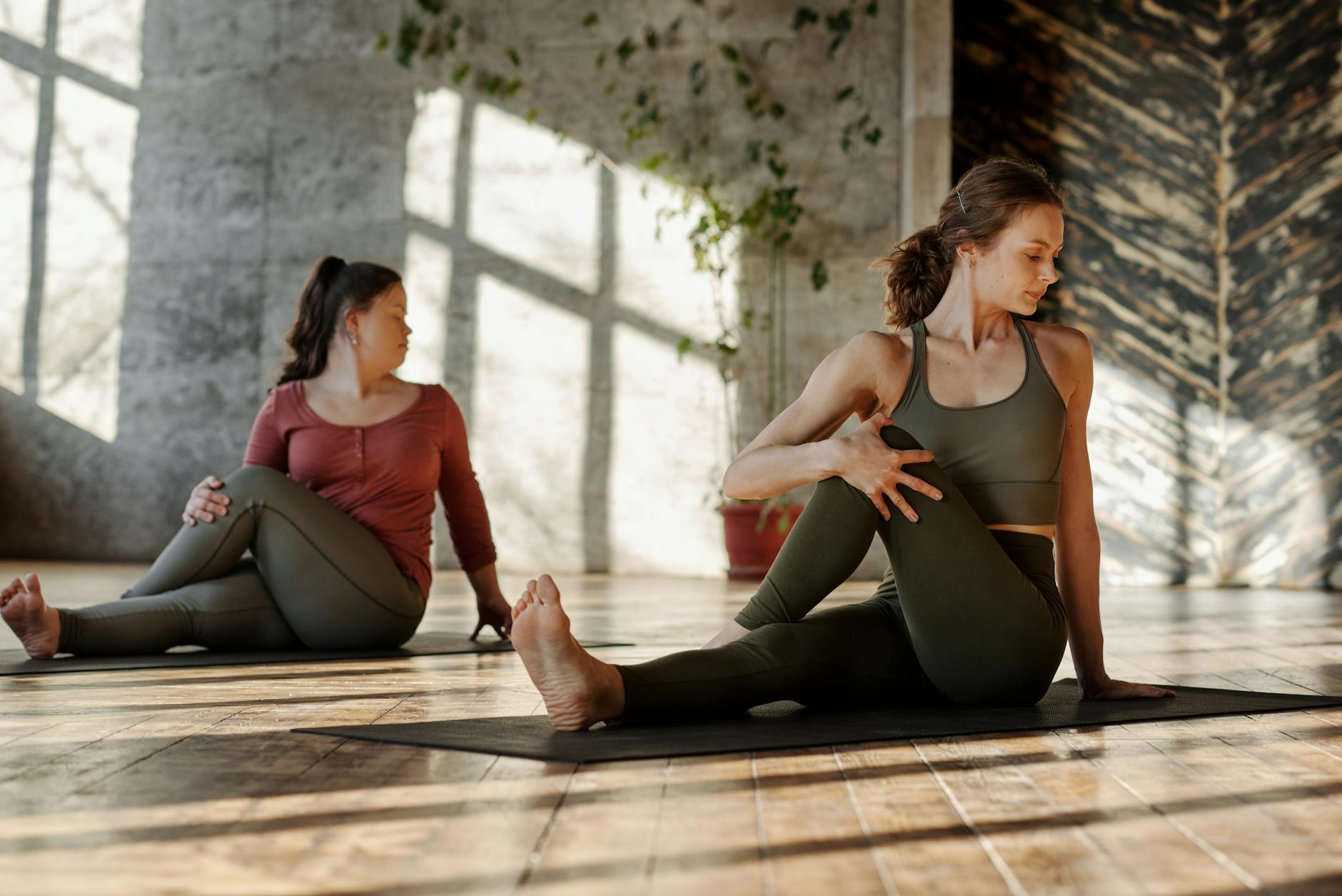No products in the cart.
No products in the cart.
Yoga has been around for thousands of years, but its benefits are timeless. From improving flexibility to reducing stress, this ancient practice does so much more than just stretch your muscles. Rooted in Indian tradition, yoga was designed to connect the mind, body, and spirit—and it’s no wonder it’s still so relevant today. Whether you’re looking to boost your physical health or find some peace in a hectic world, yoga offers something for everyone. Think of it as your all-in-one wellness toolkit—no subscription required.
Yoga is more than just physical exercise; it’s a lifestyle, a means of connecting the mind, body, and spirit. Born thousands of years ago in India, yoga draws from profound philosophical teachings. This ancient art isn’t just about touching your toes—it’s about touching deeper aspects of life. Understanding its roots and evolution gives us insight into why yoga continues to inspire and transform people worldwide.
Yoga is believed to date back over 5,000 years, making its first appearances in India’s ancient texts like the Rig Veda and Upanishads. These scriptures laid the groundwork for philosophical teachings that blended meditation, rituals, and spirituality. The Vedas, for example, contain hymns and mantras meant to create harmony between the self and the universe.
The Upanishads, which followed, delved deeper into yoga’s contemplative side. Here, concepts like connecting to the “Supreme Reality” and self-realization took shape. The Bhagavad Gita, another key text, emphasized yoga as a way of living through discipline, devotion, and mindfulness. Imagine these teachings as ancient wisdom still relevant to our increasingly chaotic modern lives.
For further exploration, check out the Vedic Origins of Yoga, which explains the foundational teachings of this practice.

Photo by Gokul Gurang
Fast forward a few centuries to Patanjali’s Yoga Sutras, where yoga’s philosophy branched into the Eightfold Path or Ashtanga Yoga. This is essentially a roadmap for living a meaningful and balanced life:
These steps remind us that yoga isn’t confined to what happens on the mat. It’s a holistic daily practice encompassing everything from how we treat others to mastering our breath. Curious to dive deeper? Explore The Eight Limbs of Yoga Explained for a deeper breakdown of each aspect.
Yoga’s journey to becoming a global cultural phenomenon is fascinating. Originally a deeply spiritual practice, it has adapted over centuries. By the late 19th and early 20th centuries, key figures like Swami Vivekananda began introducing yoga to the West. What began as lectures on philosophy eventually transformed into the yoga classes we know today.
In its modern form, yoga incorporates styles ranging from calming Hatha Yoga to dynamic Power Yoga. This evolution reflects our collective need to balance tradition with modern needs. Whether you’re twisting into a pretzel pose or practising breath control on your commute, yoga has developed to meet everyone where they are.
Want to learn more about its fascinating transition? Check out Evolution Of Yoga: From Ancient Origins To Modern Practices for an engaging history lesson.
Yoga is living proof of how ancient wisdom provides answers to even the most contemporary issues. What does this ancient practice mean to you in your daily life? Stay tuned as we continue to explore yoga’s benefits for health and well-being.
Yoga isn’t just about the spiritual connection—it’s a full-body workout designed to enhance your overall well-being. Think of it as that secret tool in your health arsenal; it works quietly in the background, helping you feel stronger, more flexible, and balanced. Its physical benefits resonate with both beginners and seasoned practitioners alike.
Do you feel stiff after sitting all day or clumsy while moving around? Yoga has your back—literally. Regular practice helps loosen up tight muscles and increases mobility. Many postures specifically target your hamstrings, hips, shoulders, and spine, making them less rigid over time.
Flexibility and balance don’t just improve how you move; they enhance your posture. Imagine standing taller and reducing stress on your joints simply by doing poses like the Downward Dog or Tree Pose. Better posture isn’t just about vanity—it helps prevent injuries and even boosts confidence as you move through your day.
Research has shown that yoga can dramatically improve balance source, especially in older adults who are at higher risk for falls. Whether you’re a student or a retiree, yoga keeps you steady—both physically and mentally.

Photo by Yan Krukau
Don’t be fooled by its calm vibe—yoga builds serious strength. Many poses require engaging your entire body to hold positions that push your limits. Take Plank Pose or Warrior Pose, for example. These challenge your core, legs, and arms all at once.
You might not lift weights in traditional yoga, but the resistance your body provides offers similar results. Want to tone your arms, abs, and glutes? Poses like Chaturanga (low push-up) or Chair Pose fire up those muscles. Over time, you’ll notice improved stamina and endurance.
For more insight on how yoga strengthens the body, check out this informative guide.
Joint pain stopping you from staying active? Even gentle yoga styles provide relief. Stretching and low-impact movements improve mobility and lubrication in the joints, reducing stiffness and discomfort. This makes yoga a great choice for anyone struggling with arthritis or recovering from injuries.
Yoga is also beneficial for bone health, especially for women prone to osteoporosis. Weight-bearing poses like Warrior II and Triangle Pose stimulate bone growth, helping to prevent loss of density over time. Remember, healthy joints and bones aren’t just about staying active—they’re key to enjoying life to the fullest.
Curious how yoga supports joint health? Dive into this resource on yoga and your joints.
Yoga isn’t just exercise—it’s a comprehensive physical therapy session. Whether you’re improving flexibility, building strength, or safeguarding your bones, it ensures you move through life with ease and confidence.
Yoga isn’t just about stretching your body—it’s equally about calming your mind. It’s like hitting a reset button for your mental and emotional health, offering a sanctuary in the chaos of everyday life. Let’s explore how yoga fosters mental clarity, soothes stress, and helps balance your emotions.

Photo by Kampus Production
We all know how stress can creep into our lives, uninvited and unrelenting. Yoga steps in as a reliable antidote. Techniques like pranayama (breath control) and meditation create a calm space within you where stress simply can’t thrive. Slow, controlled breathing can help activate your parasympathetic nervous system—the system responsible for rest and relaxation.
Ever tried the 4-7-8 breathing method? It’s as simple as inhaling for 4 seconds, holding your breath for 7, and exhaling for 8. This technique, rooted in pranayama, has been shown to ease tension quickly. Check out this guide for more ways pranayama can help reduce anxiety and induce relaxation.
The power of yoga in reducing anxiety goes beyond just a momentary fix. Consistent practice can lower cortisol levels, the hormone responsible for stress. Over time, you’ll notice a difference—not just on your mat but in how you handle life’s curveballs.
In a world full of distractions, it’s easy to lose focus. Yoga offers tools to sharpen your mental clarity through mindfulness practices like meditation and asana sequences. Moving through postures mindfully? That’s like decluttering your brain one thought at a time.
Mindfulness in yoga isn’t just fluff; it’s about rewiring how you process the world. Practices such as focusing on your breath or holding a pose require intense concentration, teaching your mind to stay present. This not only improves focus but also enhances your decision-making skills. It’s like upgrading your brain’s operating system without downloading any apps.
Research even suggests yoga can positively impact brain functionality. Curious about the science behind it? You can explore more on how yoga boosts mental sharpness.
Yoga is a mood booster, plain and simple. During a session, your body releases endorphins—the feel-good chemicals that act as natural stress relievers. It’s like giving your emotional state a warm hug.
Balancing emotional states through yoga involves more than just stretching. Active poses stimulate energy, while restful ones calm the mind. Feeling overwhelmed? Opt for restorative poses like Child’s Pose or Corpse Pose to shift into relaxation mode. Need a pick-me-up? Go for heart-opening poses like Camel Pose.
Yoga also cultivates self-awareness, allowing you to identify and manage emotional triggers more easily. Over time, emotional roller coasters turn into gentle waves. If you’re intrigued by how yoga can lift your spirits, check out this resource.
Yoga isn’t just a practice—it’s a mental and emotional lifesaver. Whether you’re fighting stress, seeking clarity, or aiming for balance, yoga offers tools that fit seamlessly into your daily life.
Yoga is far from a one-size-fits-all remedy; its adaptability makes it a powerful tool for addressing various health concerns and milestones in life. Whether you’re dealing with chronic pain, preparing for the journey of parenthood, or working toward recovery, yoga has a practice tailored just for you.
Chronic pain can feel like an unwelcome guest who never leaves—but yoga offers a way to reduce its impact. Through gentle stretching, mindful breathing, and focused relaxation, yoga helps people manage conditions like back pain, arthritis, and even migraines. How does it work? By improving blood flow, easing muscle tension, and calming the nervous system, yoga supports your body’s healing processes.
For example, poses like Child’s Pose or Cat-Cow Stretch gently stretch and realign tight areas. Plus, meditation and breathwork can interrupt the stress-pain cycle that often magnifies discomfort. Studies have shown that practices like these may lower pain intensity and increase mobility, even for persistent conditions like fibromyalgia.
If you’re curious, check out this resource discussing yoga’s role in pain management.

Photo by Cliff Booth
Pregnancy is a beautiful journey, but it comes with physical and emotional challenges. Prenatal yoga steps in to help expecting mothers build strength and flexibility while relieving common discomforts like back pain and swollen ankles. Simple poses like Warrior II for balance and Butterfly Pose for hip-opening can make movement more comfortable as the pregnancy progresses.
Postnatal yoga, on the other hand, focuses on recovery and reconnecting with your body. Gentle core-strengthening exercises aid in rebuilding abdominal muscles, while restorative poses encourage emotional well-being. Plus, engaging your baby in postnatal practices can create an even deeper bond.
Curious about how prenatal yoga prepares the body for labour? Read more about it here.
Yoga is often associated with flexibility, but did you know it’s also a heart hero? Research shows that yoga can help reduce blood pressure, regulate cholesterol levels, and even control blood sugar—crucial for managing heart disease and diabetes.
How? The magic lies in its holistic approach. Breathwork like Pranayama lowers stress, which in turn stabilizes heart rate. Meanwhile, dynamic sequences such as Sun Salutations keep blood circulating and encourage healthier body composition. Over time, these practices not only reduce cardiovascular risk but also improve overall fitness.
Learn more about yoga’s impact on heart and metabolic health here.
Rehabilitation requires physical and emotional resilience, and yoga provides both. Whether recovering from substance abuse, chronic illness, or cancer, yoga supports healing by promoting relaxation, improving strength, and encouraging mindfulness.
In substance abuse recovery specifically, yoga acts as a stress-relief valve, offering tools to manage cravings and anxiety. For cancer patients and survivors, gentle stretches combined with breathing techniques can combat fatigue and improve quality of life. Even in sports or injury rehab, poses like Downward Dog improve flexibility while reducing strain on joints.
Want to dive deeper into the therapeutic role of yoga during recovery? Check out this helpful guide.
Yoga is more than movement—it’s a life-changing practice that meets you where you are, no matter the challenge you face.
When yoga becomes more than just a workout or relaxation technique, it transforms into a lifestyle practice. This holistic approach not only changes how you move on the mat but also how you live off it. From mindful eating to seamlessly integrating yoga into your daily routine, this ancient art holds the power to enhance every aspect of life.

Photo by Elina Fairytale
Yoga teaches us to slow down and truly be present, and this principle extends effortlessly to the way we eat. Mindful eating is about tuning into your body’s hunger and fullness cues, savouring each bite, and understanding the emotions and thoughts behind your food choices. Think of it as bringing the calm of a yoga pose to your plate.
A regular yoga practice fosters awareness of how food affects not just your body but also your emotional state. Are you eating because you’re stressed or bored, or because you’re genuinely hungry? Yoga helps identify these triggers and guides us toward balanced, healthier decisions. Studies even show that mindful eating can reduce binge tendencies and promote better digestion.
Curious to learn more? Dive into this article on mindful eating practices, which explores how yoga-inspired eating habits improve overall well-being.
Life gets busy—there’s no escaping that. But making yoga a part of your daily life doesn’t have to feel like an impossible task. Small, intentional steps go a long way in building a sustainable practice. Even a quick 10–15-minute session can revitalize your body and mind.
Here are practical ways to weave yoga into your routine:
Still think you don’t have time for yoga? A simple mindset shift can help. Think of yoga as life’s quiet reset button—it doesn’t need hours; it just needs consistency. For more tips on merging yoga with a busy schedule, check out this guide on integrating yoga into daily life.
Yoga as a lifestyle doesn’t demand perfection; it’s about showing up and finding balance—both on and off the mat. Whether it’s through the way you eat or how you structure your day, yoga offers tools to lead a more mindful, intentional life.
Yoga isn’t just a workout—it’s a well-rounded approach to living better, inside and out. Whether you start for the physical benefits or the mental clarity, the ripple effects can transform your entire life.
This ancient practice doesn’t require special skills or ages. It adapts to you. From supporting stress relief to enhancing flexibility, meditation, and even chronic pain management, yoga can be your go-to for achieving balance in a busy world.
Why not roll out a mat today? Explore how just a few minutes of yoga can boost your health and well-being. Share your journey or invite others to join you—yoga is best when it brings people together. Let’s stretch ourselves toward a healthier future!
If you need any further information or assistance with this article, don’t hesitate to Contact Us
Karen Blake
BAHN-NLP
TFT-DX



